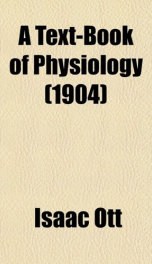a text book of physiology

Purchase of this book includes free trial access to www.million-books.com where you can read more than a million books for free. This is an OCR edition with typos. Excerpt from book: CHAPTER VI. THE CIRCULATION. In animals above the very lowest grades, as also in plants, there exists a particular liquid (nutritive fluid, blood, sap), which is agitated into a circular or simply oscillating movement. By reason of this movement it is permitted to reconstitute itself unceasingly, to distribute the materials of nutrition to the different parts of the organism, and at the same time carry away some effete products. In the lowest orders of animal life, as the amoebae and infusoria, where no special organs are manifest and no part therefore has needs differing from any other, there is found no circulatory systemno heart or propelling body or any blood-vessels. Its life depends upon diffusion throughout its parenchyma of substances brought from without and of those which must be excreted. It is only as special organs show themselves and the liquids take determined directions toward one or another of them, that blood-vessels are seen to commence; these at the same time become the receptacles of products absorbed for the purposes of nutrition and the distributors of these same materials to the various tissues of the organism. It is, therefore, from complex organisms that the idea of a perfect circulation is gained, with its admirable mechanism for incessant movement whereby the fluid necessary for its growth, functions, and individual life is forced to every part. Viewed as a whole, the vascular system of the higher animals forms a system of branching vessels or canals, closed in all parts, and not showing at any point in their course the least perceptible orifice of communication with the external world. Consequently, the fluids which have to penetrate into the closed channels of circulation, as well as those which have to emerge from them for the needs of s...
Info about the book
Author:
Series:
Unknown
ASIN:
B000PYDGCK
Rating:
3.5/5 (4)Your rating:
0/5
Languge:
English
Users who have this book
Users who want this book
What readers are saying
What do you think? Write your own comment on this book!
write a commentGenre
if you like a text book of physiology try:
Other books by this author
Do you want to exchange books? It’s EASY!
Get registered and find other users who want to give their favourite books to good hands!


